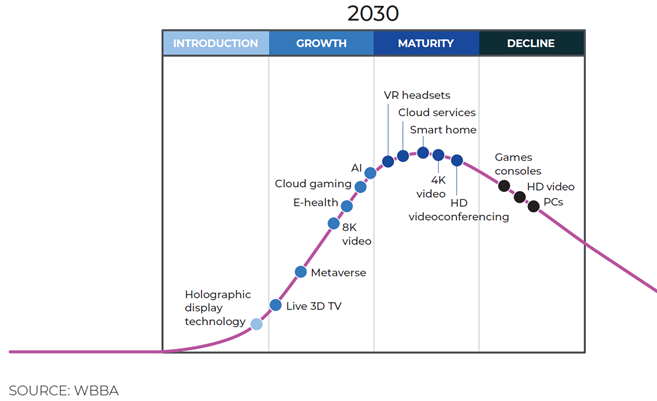The history of passive optical networking (PON) technologies has always had one eye on the present and another on the future. While BPON was being rolled out, ONTs that could auto-detect GPON were highly valued by the market in anticipation of future upgrades. While GPON emerged as the primary fiber access technology, there was wide speculation that NG-PON2 would be the next widely deployed technology. However, XGS-PON won the day and is now overwhelmingly the clear successor to GPON. Fiber Connect and the Fiber-to-the-Home Show before it have always been major events where new technologies were both debated and on display, and this year’s event continued that tradition. Multiple sessions focused on the future of fiber and the applications driving the next generation. Let’s take a look at the current technologies being deployed, the applications driving future upgrades, and what technologies have emerged as likely successors.
XGS-PON is clearly the predominant fiber technology being deployed today. It has proven to be a cable killer in the North American market, with its symmetrical multi-gigabit speeds overwhelming the capabilities of DOCSIS 3 and 4, so much so that many cable operators have chosen to leap to 10G fiber technologies rather than remain tied to DOCSIS. Thanks to high volumes of production and performance that is 4 to 8 times higher than GPON, XGS-PON ultimately has become close enough in deployment cost to GPON that in 2022 it overtook it in overall port shipments. It is a great technology, but it also has its shortcomings. For one thing, although it is touted as a 10 gig technology, its overhead prohibits it from actually delivering 10 Gbps data rates … usually capping out somewhere in the 8 Gbps range. This may seem like a minor issue, but in a world where speed can provide an advantage and perception is paramount, XGS-PON leaves the door open for new technologies to succeed it – especially when serving businesses who are willing to pay more for guaranteed 10/10 Gbps services.
New applications are also driving potential needs for higher bit rates that are already threatening to push 10 gig technologies to their limit. Omdia shared at Fiber Connect 2023 that it has seen application bandwidth growth at 40% each year, and that they expect this trend to continue. Omdia also shared at the event that connectivity is skyrocketing, both in network scope and number of endpoints. Over the next five years, shipments of connected devices are expected to increase by over 40% and installed consumer IoT products by 210%. Equally as important, many of these devices will have full HD or Ultra HD capabilities, and virtual reality (VR) devices are expected to outstrip games consoles during this time. An increasing reliance on the cloud will also have a major impact, taking the burden of performance away from the device and placing it on the network in the form of reliability, low latency, and sustained high bit rates. Omdia predicted at Fiber Connect that the number of connected devices in the home will double every 5 years, and that by 2030, the average home will have nearly 50 connected devices – all of which will be contending for bandwidth. Learn more about applications driving next-generation PON services.
This diagram from the WBBA shown at Fiber Connect provides a prediction of the adoption trends of new applications:

With some of these applications requiring multiple gigabit data rates for each instance in the home, and the potential for multiple instances simultaneously in each home, it is easy to see a future where XGS-PON does not provide enough for the home, and comes up even shorter for businesses who are constantly seeking higher data rates as they too move to the cloud and find competitive advantage in speed and agility.
So what technologies were discussed as successors for XGS-PON at Fiber Connect 2023? 25G-PON is just starting to become available in the market and meets many of the aforementioned shortcomings of XGS-PON in terms of being able to deliver guaranteed data rates of at least 10 Gbps symmetrical and meeting the needs of emerging multi-gig applications. Although it has been ratified as a standard by the ITU, it has a number of characteristics that cause it to feel like a stutter-step like NG-PON2 was as a successor to GPON.
- It is primarily a technology produced and driven by Nokia, giving it the potential to reach critical mass because of Nokia’s size, but unlikely to be accepted by the rest of the industry.
- Historic leaps in mass deployed PON technologies have been at least 4-fold in terms of data rate (622/155 Mbps BPONà5/1.2 Gbps GPON à 10/10 Gbps XGS-PON). 25G-PON would break this trend, which raised a major red flag among many service providers and vendors alike at Fiber Connect 2023.
- Major silicon vendors like Broadcom shared that 50G-PON standardized by the ITU was their target technology, and that chips for testing would be available in 2024.
- Omdia sees 50G-PON scaling to match 25G-PON shipments by 2028, and growing faster after that.
So what does this all mean for service providers? There are 3 key takeaways that were discussed at Fiber Connect 2023:
- XGS-PON will be the right choice to deploy for the next few years.
- That said, technologies like 50G-PON are on the horizon, and the path to demand driven by emerging applications and the competitive landscape is clear.
- Service providers planning to deploy XGS-PON today should choose platforms with the headroom and capacity to upgrade to new technologies like 50G-PON in the future – ideally through in-place upgrades.
At Fiber Connect, DZS had on display its Velocity portfolio of Access EDGE optical line terminal (OLT) systems. Available in a variety of sizes and configurations – from 1RU fixed form factors to 2, 6, 14 and 16 slot chassis – these systems lead the industry in performance and capacity. For example, the 6-slot Velocity V6 is capable of supporting 800 Gbps per slot non-blocking, enough to support not only XGS-PON data rates today, but 50G-PON and even 100G-PON data rates in the future. Thus, service providers can rest assured that they will have the capacity to make in-place upgrades to next-generation PON technologies like 50G-PON in the future without a forklift, saving both time and money for the service provider. All Velocity systems are also environmentally hardened and can be deployed in new or existing cabinets at the Access EDGE. Learn more about the award-winning Velocity portfolio.
One example provided at Fiber Connect 2023 was that of a DZS customer, Mid-Hudson Cable outside of New York City, who deployed the Velocity V6 specifically to counter an aggressive XGS-PON overbuilder that was encroaching on their territory and promoting a future of 10 gig services. Aggressively taking back technology leadership in their market from this competitor, Mid-Hudson Cable deployed the Velocity V6 because it provided them the ability to leap to 50G-PON rapidly in the future with in-place upgrades. Mid-Hudson is now successfully retaining and even expanding their customer base in their region. To learn more about Mid-Hudson’s response, see this press release.
Indeed, next-generation technologies were widely discussed at Fiber Connect 2023, and a clear path forward began to emerge. It will certainly be interesting to see progress on this subject at Fiber Connect 2024! In the meantime, we encourage you to read this white paper on how a 100G future is closer than you think.
Next, we discuss the final two topics widely discussed at Fiber Connect – how to develop a successful fiber strategy and the importance of becoming an experience provider. Read Part 5: Developing a Successful Fiber Strategy…Start with the Customer Experience and Work Backwards.



 '
'